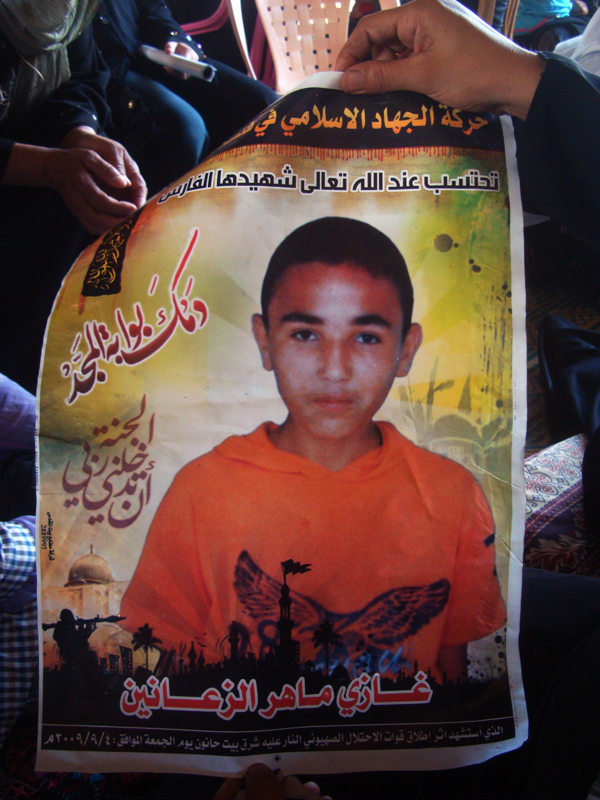Wednesday 14th January, 2009
In an escalation of the ground offensive in the south of Gaza, Israeli forces terrorised the population of Khoza’a, a small rural community east of Khan Younis. They entered the area at about 3.00am on the morning of Tuesday 13th January in an incursion lasting until Tuesday evening. This follows heavy missile strikes on Khoza’a in recent days, notably on Saturday 10th January.
According to a local municipality official, approximately 50 homes were bulldozed along with farmland, olive and citrus groves. The scent of lemons could faintly be determined whilst navigating the wreckage, emanating from so many mangled trees. A family explained how their home was demolished with them inside it. They sheltered in the basement as the upper storeys were destroyed. Later they realized the basement itself was being attacked and narrowly missed being crushed to death by escaping through a small hole in the debris.
Iman Al-Najar was with her family in their home when military D-9 bulldozers began to demolish it. They managed to escape and Iman then encouraged some of her neighbours to try to leave the vicinity. The group of women were instructed by Israeli soldiers to leave by a particular street. They had children with them and carried white flags, yet when they reached the street Israeli special forces concealed in a building opened fire on them and shot 50 year-old Rowhiya Al-Najar. The other women desperately tried to rescue her but the gunfire was too heavy and they had to flee for their lives. An ambulance was also prevented from reaching her and she bled to death in the street.
Meanwhile Iman and about 200 other residents whose homes had been destroyed had gathered near her uncle’s house which was protecting them to some degree from the shooting. However, this area in turn was also attacked. Iman described how the bulldozers began piling debris up around them, effectively creating a giant hole that they were standing in. They were literally about to be buried alive. By some miracle they managed to also escape from this situation by crawling on their hands and knees for about 150 metres. It was extremely difficult for them to move, especially with the injured and the elderly.
The terrified residents then sought sanctuary at a local UNRWA school. But when they got there missiles were being fired around it and they had to retreat. Finally they managed to leave the area entirely and walked several kilometres to where friends were able to pick them up. Iman’s 14 year-old brother Mohammed was missing for 12 hours and she feared he was dead. He had been detained by soldiers in a house along with a neighbour who had begged to be let out to find her children but was not allowed to do so. When the soldiers had shot Rowhiya Al-Najar, Mohammed said they had been singing and dancing and forced him to do the same. When he refused, they threatened to shoot him too.
“It was the hardest day of our lives,” repeated Iman over and over again. She had nothing left in the world but the clothes she was standing up in, but under the circumstances she was lucky to escape with her life. As in so many other parts of the Gaza Strip, the atrocities committed against civilians in Khoza’a amount to war crimes.
Missiles believed to contain white phosphor were deployed by the Israeli military during this attack. ISM volunteers photographed a fist-sized lump of flaming material found on the ground next to a burnt-out home. It was still burning from the previous day. The only way to extinguish it was to bury it, but it would instantly re-ignite if uncovered. It was giving off a thick grey smoke with a foul stench. Doctors at the Al Nasser Hospital in Khan Younis, which received 50 casualties that day from Khoza’a, described serious chemical burns and victims being covered in a white powder which continued to burn them. Many people were also suffering from serious breathing difficulties after inhaling smoke emitted by this weapon.
Before the Israeli war on Gaza began, the ISM team here had been working with the farming community in Khoza’a, accompanying local farmers as they succeeded to access their land to plant winter wheat. The IOF had prevented them from reaching their fields, in some cases for over five years. Israeli soldiers shot at them, even during the ceasefire. The same ceasefire which Israel claims was broken by Palestinians.



